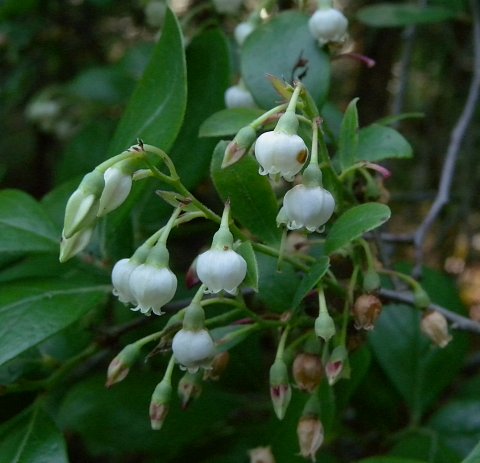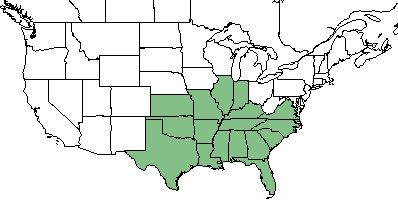Difference between revisions of "Vaccinium arboreum"
(→Phenology) |
Lsandstrum (talk | contribs) (→Habitat) |
||
| Line 36: | Line 36: | ||
The species has a medium tolerance to drought and is tolerant of shade. <ref name= "USDA"> [https://plants.usda.gov/core/profile?symbol=CEAM USDA Plant Database]</ref> | The species has a medium tolerance to drought and is tolerant of shade. <ref name= "USDA"> [https://plants.usda.gov/core/profile?symbol=CEAM USDA Plant Database]</ref> | ||
<!--Natural communities, human disturbed habitats, topography, hydrology, soils, light, fire regime requirements for removal of competition, etc.--> | <!--Natural communities, human disturbed habitats, topography, hydrology, soils, light, fire regime requirements for removal of competition, etc.--> | ||
| + | |||
| + | ''V. arboreum'' responds negatively to soil disturbance from agriculture in South Carolina's longleaf communities.<ref>Brudvig, L.A. and E.I. Damchen. (2011). Land-use history, historical connectivity, and land management interact to determine longleaf pine woodland understory richness and composition. Ecography 34: 257-266.</ref> | ||
===Phenology=== | ===Phenology=== | ||
Revision as of 14:17, 27 June 2019
Common names: farkleberry[1], sparkleberry [2], winter huckleberry [3], tree sparkleberry [4], tree huckleberry [5]
| Vaccinium arboreum | |
|---|---|

| |
| Photo by John Hilty hosted at IllinoisWildflowers.info | |
| Scientific classification | |
| Kingdom: | Plantae |
| Division: | Magnoliophyta - Flowering plants |
| Class: | Magnoliopsida - Dicots |
| Order: | Ericales |
| Family: | Ericaceae |
| Genus: | Vaccinium |
| Species: | V. arboreum |
| Binomial name | |
| Vaccinium arboreum Marshall | |

| |
| Natural range of Vaccinium arboreum from USDA NRCS Plants Database. | |
Contents
Taxonomic Notes
Synonym: V. arboreum var. glaucescens (Greene) Sargent; Batodendron arboreum (Marshall) Nuttall
Description
V. arboreum is a perennial shrub/tree of the Ericaceae family that is native to North America. [1]
Distribution
V. arboreum is found throughout the southeastern United States, as far west as Texas and as far north as Illinois. [1]
Ecology
Habitat
Common habitats for V. arboreum include rocky or sandy woodlands, bluffs, and cliffs. [6] Specimens have been collected from longleaf wiregrass sand ridge, broadleaf tree stand, high hammock, upland woodland, live oak hammock, mixed hardwood forest, and in beech magnolia woods. [7]
V. arboreum can grow in medium to coarse textured soils.[1]
The species has a medium tolerance to drought and is tolerant of shade. [1]
V. arboreum responds negatively to soil disturbance from agriculture in South Carolina's longleaf communities.[8]
Phenology
V. arboreum has been observed to flower January through May and October with peak inflorescence in April. [9]
Fruit begins to develop in summer and lasts to fall. [1]
Seed dispersal
This species is thought to be dispersed by consumption by vertebrates. [10]
Fire ecology
V. arboreum has a medium tolerance of fire. [1]
Given V. arboreum is usually maintained by fire, when the habitat is fire suppressed the species will grow to maturity and taller than in fire maintained regions. [6] [11]
Conservation and Management
Cultivation and restoration
Photo Gallery
References and notes
- ↑ 1.0 1.1 1.2 1.3 1.4 1.5 1.6 USDA Plant Database
- ↑ Behm, A. L., et al. (2004). "Flammability of native understory species in pine flatwood and hardwood hammock ecosystems and implications for the wildland-urban interface." International Journal of Wildland Fire 13: 355-365.
- ↑ Blair, R. M. (1971). "Forage production after hardwood control in a southern pine-hardwood stand." Forest Science 17(3): 279-284.
- ↑ Bowman, J. L., et al. (1999). Effects of red-cockaded woodpecker management on vegetative composition and structure and subsequent impacts on game species. Proceedings of the Fifty-third Annual Conference, Southeastern Association of Fish and Wildlife Agencies. A. G. Wong, P. Doerr, D. Woodward, P. Mazik and R. Lequire. Greensboro, NC, Southeastern Association of Fish and Wildlife Agencies: 220-234.
- ↑ Lay, D. W. (1956). "Effects of prescribed burning on forage and mast production in southern pine forests." Journal of Forestry 29(9): 582-584.
- ↑ 6.0 6.1 Weakley, A. S. (2015). Flora of the Southern and Mid-Atlantic States. Chapel Hill, NC, University of North Carolina Herbarium.
- ↑ URL: http://herbarium.bio.fsu.edu. Last accessed: June 2018. Collectors: Florida (Okaloosa, Leon, De Soto, Suwannee, Gadsden, Leon, Wakulla, Taylor, Clay, Hillborough, Levy, Hernando, Citrus, Alachua, Volusia, Walton, Marion, Hamilton, Escambia, Lafayette, Sarasota, Jackson, Holmes, Baker) Georgia (Thomas, Grady) States and counties:
- ↑ Brudvig, L.A. and E.I. Damchen. (2011). Land-use history, historical connectivity, and land management interact to determine longleaf pine woodland understory richness and composition. Ecography 34: 257-266.
- ↑ Nelson, G. PanFlora: Plant data for the eastern United States with emphasis on the Southeastern Coastal Plains, Florida, and the Florida Panhandle. www.gilnelson.com/PanFlora/ Accessed: 29 MAY 2018
- ↑ Kirkman, L. Katherine. Unpublished database of seed dispersal mode of plants found in Coastal Plain longleaf pine-grasslands of the Jones Ecological Research Center, Georgia.
- ↑ Rodgers, H. L. and L. Provencher (1999). "Analysis of Longleaf Pine Sandhill Vegetation in Northwest Florida." Castanea 64(2): 138-162.